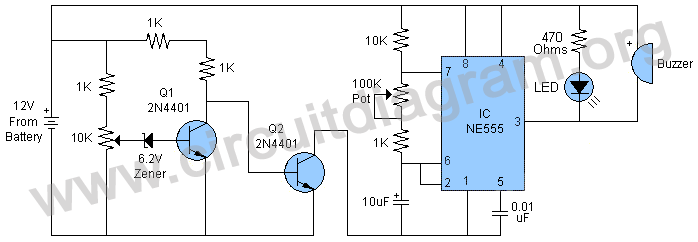
If LED is off the normal charging of the battery is ensured. Turning the switch off helps to protect the battery from overheating. Thus, LED 2 is used to indicate over charge voltage situation. When battery voltage reaches higher then predetermined value LED 2 start to glow. Similarly, VR 2 is used to adjust the higher voltage of battery. Thus, LED 1 is used to indicate under charge voltage situation. When battery voltage reaches lower then predetermined value LED 1 start to glow. Potentiometer VR 1 is used to adjust the lower voltage of battery. The zener diode connected in the circuit is in reverse mode in order to produce regulated output of 3.6V. Check the polarity properly while making connections with the 12V battery. The level monitoring circuit is fixed to the battery as shown in circuit. The status of batteries also needs to be monitored constantly, This, circuit does the job. The main components of Battery State Indicator circuit are three low power general purpose transistor 2N2222. The circuit of Battery Status Indicator Capacitor is shown in figure 1. But sound is piercing-no ignoring it or not hearing it.Circuit Description of Battery Status Indicator Had my doubts after opening the package, buzzer is only about 1/2in. Once triggered, capacitors drive alarm for about 1 1/2 seconds. Takes it about half a second to trigger due to minimal self consumption of power, before it draws down the capacitors enough to trigger. 12v in is thru a 0.2 amp light bulb, helps with charge spike but more to draw off residual system power before alarm, then thru diode so caps dont feed source. Used 4 16v/1500uF capacitors to power it. Using in camper to add 12v disconnect alert, primarily for LP detector. They are also very inexpensive for what you get. These things are loud, tiny and easy to setup. I was using a variable voltage DC source with a multi meter attached so I know that it was the units themselves that were bad.Īll of the specifications match what is given. I did not try the other six as I decided to leave them in the original packaging. I will be sending them back but do not like having to pay shipping to return DEFECTIVE merchandise. When I went to calibrate the alarm voltage they immediately alarmed and would not shut down until the voltage was above 13.9VDC no matter what I did with the adjustment screw. Ordered ten of these, unpacked and wired up four of them with 16g wire and alligator clips. Ether they did not know how a multi turn pot works or you need to adjust the pot clockwise to lower the set point. So either this is not behaving as I expected or my test set up is flawed.Ĭustomer did return them, tested the four opened parts all tested good. So I adjust to begin squeaking at 11.5 V but don't get a real screech until 10 V. In testing on my workbench with a battery and 5K potentiometer it squeaks softly for a variety of voltages approaching the specified voltage, then screeches loudly only at a much lower voltage. I was expecting this device to remain quiet until the specified voltage was reached, then screech. As I attach the charger it lights up and chirps for a second as the voltage rises. Unfortunately, when I find my battery down to 10 volts, this gadget is dark and silent. I expected that this would be making noise from the set voltage point down to 5 or 6 volts. Product Reviews Click here to review this item


Electronic Test Leads, Scope Probes and Clips.Cooling Modules, Peltier Thermoelectric.


 0 kommentar(er)
0 kommentar(er)
